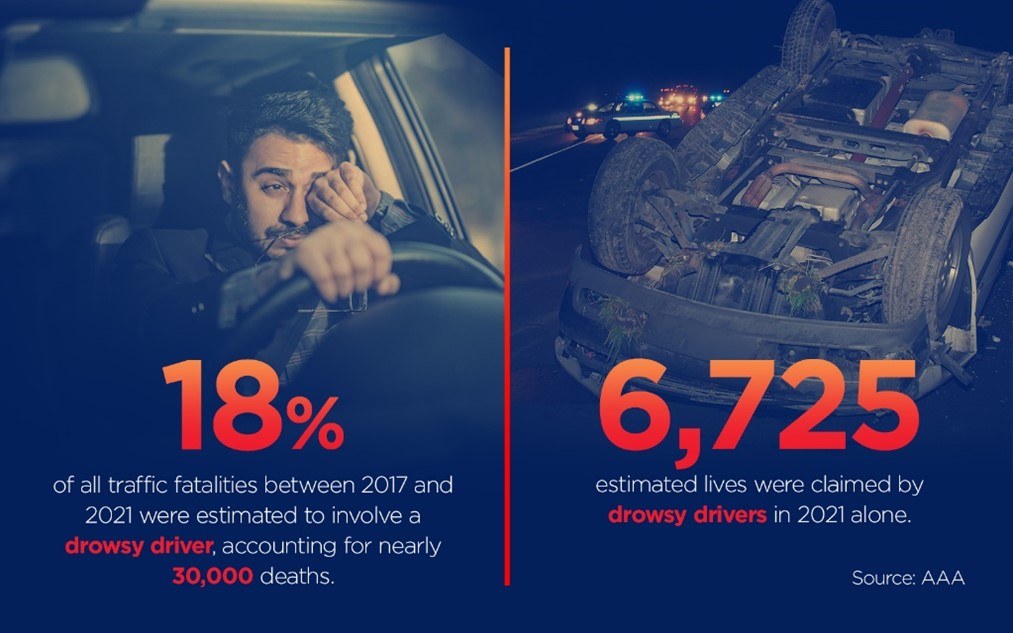Start of Daylight Saving Time (March 10) can lead to drowsy driving
PORTLAND, Ore., – New research from the AAA Foundation for Traffic Safety shows that about 18% of all traffic deaths between 2017 and 2021 involved a drowsy driver, with nearly 30,000 nationwide. This is 10 times higher than the total in traditional crash data.
In 2021 alone, about 6,725 lives were claimed by drowsy drivers.
With the switch to Daylight Saving Time happening this Sunday (March 10 at 2 a.m.), the darker mornings and lost hour of sleep can lead to more drowsy drivers.
Here are links to the report and B-roll video.

The AAA Foundation for Traffic Safety’s study is based on in-depth crash investigations and national fatal crash data. Previous AAA Foundation research points directly to sleep loss as a key factor in drowsy driving crashes.
Drowsy driving crashes are often underreported. According to NHTSA, there is agreement across the traffic safety, sleep science, and public health communities that the impact of drowsy driving is underestimated. The most recent AAA Traffic Safety Culture Index finds that 95% of drivers view driving when they have a hard time keeping their eyes open to be very or extremely dangerous, but 18% reported doing so in the previous 30 days before the survey.
Drowsiness impairs drivers in several ways:
Reduced alertness: Makes it harder to react quickly to hazards. Just one hour less than the expert-recommended minimum of 7 hours of sleep increases a driver’s risk of crashing.
- Impaired judgment: Increases the risk of making poor decisions on the road. Sleep deprivation increases a driver’s risk of making many ordinary mistakes, leading to crashes. Those deprived of sleep by 4+ hours have an impairment similar to those over the legal BAC limit.
- Hazardous Microsleeps: Can cause momentary lapses in consciousness, leading to loss of control of the vehicle and failure to respond to dangers on the road.
Self-Perception of Drowsiness: Previous Foundation research found that drivers often underestimate their drowsiness, putting themselves and others at risk.
AAA has advice for drivers:
- Get enough sleep before driving. Aim for at least seven hours of sleep per night.
- Travel at times of the day when you are normally awake. Avoid driving when you are tired or sleepy.
- Take breaks every two hours or 100 miles. Get out of the car, stretch your legs, and get fresh air. Plan and identify safe, comfortable places to take breaks. Don’t wait until you’re already feeling drowsy to pull over.
- Avoid heavy meals before driving. Eating a large meal can make you feel tired and sluggish.
- Avoid alcohol and drugs. Both can impair your driving ability and can also amplify drowsiness.
- Listen to your body. If you start to feel tired, pull over and take a break. Don’t try to push through it.
- Travel with an alert passenger and take turns driving. Sharing the driving can help you stay awake and alert.
- Don’t underestimate the power of a quick nap. A 20- to 30-minute nap can significantly improve your alertness.
“Many drivers falsely believe that drinking coffee or energy drinks, rolling down the windows, and singing along to their favorite tunes can help fight off fatigue, but these are not effective ways to keep drivers alert,” says Marie Dodds, public affairs director for AAA Oregon/Idaho.
AAA supports the development of vehicle technology that can detect drowsiness and prevent drivers from operating a vehicle when impaired. This technology could help to save lives by preventing drowsy driving crashes.
About the AAA Foundation
Established in 1947 by AAA, the Foundation for Traffic Safety is a nonprofit, publicly funded 501(c)(3) charitable research and educational organization. The AAA Foundation’s mission is to prevent traffic deaths and injuries by researching their causes and by educating the public about strategies to prevent crashes and reduce injuries when they do occur. This research informs the development of educational materials for drivers, pedestrians, bicyclists, and other road users.
About AAA
Started in 1902 by automotive enthusiasts who wanted to chart a path for better roads in America and advocate for safe mobility, AAA has transformed into one of North America’s largest membership organizations. Today, AAA provides roadside assistance, travel, discounts, financial and insurance services to enhance the life journey of over 64 million members across North America, including over 57 million in the United States. To learn more about all AAA offers or become a member, visit AAA.com.
AAA news releases, high resolution images, broadcast-quality video, fact sheets and podcasts are available on the AAA NewsRoom at NewsRoom.AAA.com.
Find local news releases at https://oregon.aaa.com/community/media/media-contacts.html
Fuel prices are updated daily at AAA’s Daily Fuel Gauge at AAA Gas Prices. For more info go www.AAA.com. AAA Oregon/Idaho provides more than 890,000 members with travel, insurance, financial and automotive-related services, and is an affiliate of AAA National, serving more than 64 million motorists in North America.

